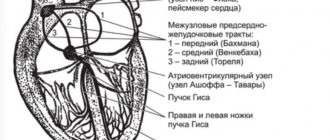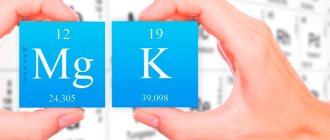Vascular problems occur in most of the population over the age of 40. They lead to disruptions in the functioning of internal organs and systems and can pose a danger to human life. For this reason, it is important to identify them in time in order to begin treatment and stop the development of pathology in the early stages. Clinical signs of vascular disorders differ depending on the location of the damaged vein or artery. Treatment is selected individually: in mild cases, correction of diet and lifestyle is sufficient, in severe cases, surgery may be required.
Features of the human cardiovascular system
The cardiovascular system is a branch of veins and arteries that reach the most distant parts of the body. Her work is based on her heart. This organ, through its contractions, creates pressure for the movement of blood along the vascular bed and sets a certain pace. In the human body there are two circles of blood circulation: large and small. In general, the liquid moves as follows:
- from the left ventricle of the heart, arterial blood moves through the aorta and large arteries to the capillaries;
- gas exchange occurs in the capillary network: cells receive oxygen, and the blood is saturated with carbon dioxide;
- venous blood flows through small venules, which then connect into large veins and empty into the right atrium.
The pulmonary circulation begins from the right ventricle. Through the pulmonary artery, venous blood enriched with oxygen flows to the lungs, where it is saturated with oxygen. Then it returns to the left atrium to carry the necessary substances to all organs and tissues.
IMPORTANT! Normally, the walls of blood vessels are strong and elastic. With age or due to illness, they can lose these qualities, which is why blood does not flow to distant parts of the body. Circulation can also be impaired when sediment accumulates on the inner wall of veins and arteries.
Causes
Diseases of the veins and arteries most often appear in people over 40 years of age, but can occur at any age. They are interconnected with the condition of the heart, spine, endocrine and other systems. In most cases, they progress gradually, so it is possible to stop their development in the early stages, when the first signs appear.
The causes of vascular diseases can be congenital or acquired. The first category includes anomalies of their structure, but there are also predisposing factors that cause problems with blood circulation in a previously healthy person:
- climatic conditions - living in stuffy regions with high air pollution, which is associated with constant hypoxia (oxygen deficiency);
- bad habits – smoking is one of the main causes of cardiovascular diseases;
- poor nutrition - cholesterol, which is found in excess in animal fats, is deposited on the walls of blood vessels;
- stressful situations that cause constant changes in the concentration of hormones that affect vascular tone;
- excess weight – it is associated with an increased load on the heart and blood vessels;
- insufficient physical activity - in such people the blood circulation rate is slow and the distal parts do not receive enough oxygen and nutrients.
In addition to lifestyle, the condition of blood vessels is also affected by diseases of other organs and systems. Thus, various curvatures of the spine cause compression of blood vessels. Heart failure and heart defects are another factor that causes circulatory problems.
Ignoring headaches is dangerous, as they can signal dangerous arterial diseases.
Symptoms of vascular disorders
Vascular problems are various acute and chronic diseases that are accompanied by circulatory disorders. Their symptoms may vary depending on the type of vessel and its location. To begin treatment, it is important to understand the cause of the pathology. Among the main phenomena that can affect the movement of blood through the arteries are:
- hypertension - increased pressure inside blood vessels, which may be associated with a decrease in the tone of muscle walls, vascular spasms, disruption of nervous and humoral regulation;
- atherosclerosis is a chronic, gradually progressive disease, during which cholesterol deposits appear on the inner wall of the arteries, and their lumen narrows;
- osteochondrosis - blocking of the lumen of the arteries due to destructive changes in the cartilage tissue of the intervertebral discs and deterioration of blood flow (in most cases occurs in the cervical spine).
A common vein disease is varicose veins, or varicose veins. It is manifested by a decrease in the tone and elasticity of blood vessels, as a result of which they expand under blood pressure. In some areas, pockets filled with blood appear. The fluid may become thicker, causing clots (thrombi) to form in the lumen of the vessels. These processes are accompanied by inflammation of the veins (phlebitis). Most often, they are interrelated, and varicose veins develop in combination with thrombophlebitis.
Vessels of the head and neck
Symptoms of problems with the blood vessels of the head and neck develop in stages. At the first stage, the patient experiences a slight decrease in performance, drowsiness and memory impairment. Further clinical signs become more pronounced:
- headaches and dizziness;
- unsteadiness of gait, poor coordination of movements;
- cognitive disorders, memory loss;
- disorders of the pelvic organs;
- in the last stages - paresis, paralysis of the limbs, disorders of higher nervous activity.
IMPORTANT! Treatment will be most productive in the early stages. With further progression of vascular diseases, the changes may be irreversible.
Coronary vessels
Coronary arteries are vessels that participate in the blood supply to the heart muscle. As blood flow deteriorates, the characteristic symptoms of angina pectoris occur. It can be diagnosed by the following signs:
- weakness, fatigue;
- increased heart rate even with minor exertion;
- characteristic painful sensations behind the sternum (pressing, aching), which intensify with physical activity or nervous tension;
- constant shortness of breath.
With a constant lack of oxygen and nutrients, the cells that make up the muscle layer of the heart die. In advanced cases, this can cause strokes or heart attacks. These pathologies are life-threatening in the absence of emergency medical care.
Arteries and veins of the extremities
Problems with the veins and arteries of the extremities are common. Since blood enters these sections last, when blood circulation slows down, it practically does not flow to the arms and legs. Cells do not receive enough oxygen and nutrients, so they cannot perform their functions.
Patients present with complaints of the following symptoms:
- numbness of the hands and feet, coldness of the extremities;
- tingling sensations in the fingers and toes;
- pain that occurs both during physical activity and at rest;
- the skin becomes pale, sometimes acquiring a bluish tint;
- additional signs: deterioration of the skin and its dryness, thinning and brittle hair and nails.
Another characteristic symptom of insufficient blood supply to the extremities is periodic lameness. It occurs suddenly and manifests itself as acute pain in the legs after covering even a short distance. In advanced cases, vascular disease may become the basis for emergency surgery. With prolonged oxygen deficiency, tissue necrosis develops, which causes irreversible changes - trophic (non-healing) ulcers or gangrene.
A constant feeling of cold in the distal extremities is one of the first symptoms of vascular disorders
Dilated veins
A common problem that indicates vascular dysfunction is varicose veins. It occurs in any part of the venous system, but the vessels in the legs are most often affected. Varicose veins are not only an aesthetic problem. Varicose veins are often accompanied by pain and heaviness in the legs, swelling and cramps - characteristic symptoms of vascular disease of the extremities. As a result of complications of the disease, there is a threat of thrombosis and the appearance of trophic ulcers. If you have the above symptoms, contact a specialized vascular center or make an appointment with a phlebologist.
Diagnostic methods
Before starting treatment, it is important to determine what processes occur in the vessels and what caused the disease. To do this, they diagnose not only the condition of the arteries and veins, but also the internal organs. The final diagnosis can only be made based on the results of a comprehensive examination, which will include the following tests:
- general and biochemical blood tests;
- blood clotting rate tests (to identify the risk of thrombosis);
- lipidogram is a type of biochemical blood test that is performed to determine the level of triglycerides (including cholesterol, the cause of atherosclerosis);
- tests for markers of damage to cardiomyocytes - cells of the muscular lining of the heart.
It is also necessary to conduct a number of instrumental studies. There are specific techniques that allow you to monitor the speed and intensity of blood flow throughout the entire vessel: angiography and Dopplerography. It is also useful to obtain an electrocardiogram to diagnose heart disease. CT and MRI are considered the most reliable methods for assessing the condition of blood vessels. They allow you to obtain a three-dimensional image in several projections, regardless of the location of the vein or artery.
Diagnosis of varicose veins:
- Examination and history taking;
- Duplex scanning of veins;
- Ultrasonography;
- Phlebography of the veins of the extremities;
- Phlebomanometry.
After examining the patient, the doctor determines the need for one or another type of vascular diagnostics. When the disease is diagnosed, the patient is offered the following treatment methods for varicose veins:
- Removal of affected veins (phlebectomy)
- Laser photocoagulation;
- Sclerotherapy (with the help of a special substance, damaged veins seem to stick together and disappear);
- Radiofrequency coagulation of veins.
Principles of treatment
The treatment regimen is selected individually and depends on the specific diagnosis. Most vascular problems can be treated with medications, without the need for surgery. All patients, regardless of the type of vascular disorder, are also given advice on proper nutrition and other aspects of life.
Nutrition and lifestyle
Fatty foods, bad habits, a sedentary lifestyle and excess weight are the main factors that trigger pathological processes in blood vessels. Treatment with medications will not be effective if you do not follow simple rules:
- completely exclude fried and fatty foods, salty foods and sweets in large quantities from the diet;
- give up bad habits: smoking and alcohol;
- pay attention to simple physical activity, including walks in the fresh air;
- normalize sleep and wakefulness - the body needs at least 8 hours of sleep daily;
- avoid stress.
Diet and normal physical activity will allow you to gradually lose excess weight without stressing the body. Extra pounds are also one of the main causes of heart and vascular diseases.
IMPORTANT! Exercises to maintain muscle tone should be discussed with your doctor. Thus, with varicose veins, sports are allowed provided that an elastic bandage or bandage is used. Heart defects are a contraindication to intense exercise, but walking is allowed.
Medicines
Medicines are prescribed individually. Patients often have to take several drugs at the same time, which belong to different pharmacological groups. To normalize blood pressure, medications are needed to control it; for varicose veins, venotonics; for high cholesterol levels, lipid-lowering medications. To monitor their effectiveness, it is necessary to periodically undergo routine examinations and monitor blood counts.
Surgical intervention
Most often, surgical treatment is necessary for thrombosis. The operation is prescribed if there is a risk of a blood clot breaking off or in case of complete blockage of the vessel with the formation of pockets. It is performed by resection of the section of the artery or vein that contains the blood clot. Modern medicine also offers less invasive techniques. They involve installing a shunt to ensure normal blood supply to the tissues.
Treatment of vascular problems is carried out after a complete diagnosis of their condition. It should be understood that the doctor’s recommendations should be followed throughout life. Failure to follow simple rules can lead to exacerbation of the disease, including after successful drug or surgical treatment.
Prevention of vascular diseases
Prevention of vascular diseases is the reduction or complete elimination of risk factors, as well as the normalization of blood flow.
This is mainly facilitated by a healthy lifestyle:
- weight control;
- avoiding hypothermia;
- proper nutrition, which limits the total caloric content of food, as well as the content of salt and fat in it. With this diet, preference is given to fish, vegetables and vegetable oils;
- to give up smoking;
- limiting emotional overload and stress;
- limiting prolonged standing;
- timely treatment of hypertension and diabetes.








